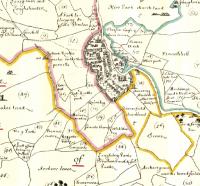The Down Survey of Ireland project
Published in 1641 Rebellion, Confederate War and Cromwell, Cromwell, Early Modern History (1500–1700), General, Issue 2 (March/April 2013), News, Volume 21
The Down Survey map of Kilkenny and environs. (Trinity College, Dublin)
Following the 1641 uprising, the Confederate wars and the Cromwellian conquest, the English Commonwealth was obliged to redeem debts owed to soldiers and adventurers with land in Ireland seized from Catholic rebels. The adventurers comprised mainly London merchants and English landowners who had put up money at the start of the war to fund the reconquest of Ireland in return for the promise of substantial lands there.
The Down Survey is part of a group of surveys compiled in quick succession to satisfy these claims: the Gross Survey of 1653; the Civil Survey of 1654; and, following these, the mapped Down Survey of 1656–8. The Gross Survey was intended to determine the value of the lands to be distributed to soldiers in lieu of their arrears of pay. The Civil Survey was a full schedule of all of the forfeited lands in fifteen counties, recording their area, value and owners at the outbreak of the uprising. The surveyors were instructed to visit each area of the country and collect all existing material relating to land ownership, including surveys, rentals, deeds and valuations.
This Civil Survey was found to be inaccurate by many of the new owners. In order to satisfy the many claims and complaints, William Petty, physician-general of the English army in Ireland, was employed to perform an exact, mapped survey of the lands, called the Down Survey as ‘a chain was laid down, and a scale made’. The Down Survey, undertaken by groups of soldiers under Petty’s supervision, was the most ambitious and detailed mapped survey of any country and set the standard for future colonial surveys. These maps were to be used with the Books of Survey and Distribution, a compilation of all the previous surveys into land ownership. The combined sources comprise a complete list of every townland, parish and barony in Ireland, the acreage of each townland, the type of land and the owner in 1641. The ‘distribution’ component lists the owners in 1670, following the settlement of all claims.
The result was a single source of maps and data, but unfortunately a fire broke out in the surveyor general’s office in 1711, destroying the maps for Connacht and parts of Munster and Leinster. A small number of copies had been made before the fire, and numerous copies were made of the surviving maps prior to the complete destruction of the manuscripts in the Four Courts at the outbreak of the Civil War in 1922. These copies are now in a host of libraries and archives throughout Ireland, Britain and France.
A contemporary copy of the barony maps was taken by William Petty into his private possession. These manuscripts were being transferred from Ireland to his family estate in England in 1707 when they were captured by French pirates; they are now in the Bibliothèque National de France (BNF) in Paris. A smaller contemporary set of barony maps made by Thomas Taylor are in the National Archives of Ireland. An early, private, imprint of the first atlas of Ireland (1670), also in the BNF, has been digitised for use in the site.
Tracings were made of all the surviving copies of seventeenth-century parish maps for Griffiths’s Boundary Survey of 1824 and were used to create the first Ordnance Survey maps in the 1830s.
Additional sources that have been included in the project are the 1659 census and recordings of murders in the 1641 Depositions. The 1659 census covers much of the country and records the number of inhabitants of each townland and the names of some of the principal tenants. The 1641 Depositions are a collection of 8,000 witness statements kept at Trinity College. They became the chief evidence for the hotly contested allegation that Irish Catholics had massacred hundreds, if not thousands, of their Protestant neighbours. The Down Survey project has reassembled these surveys and sources and rendered them into a digital Geographical Information System (GIS).
An overlay of the first atlas of Ireland and the first edition of the Ordnance Survey has been synchronised to a Google Maps platform, and the Books of Survey and Distribution database has been linked to the modern townland index, enabling us to geo-reference, with a high degree of accuracy, any historical source.
The site consists of two main components. The principal part comprises high-resolution images of all the surviving Down Survey maps. The GIS section stores information relating to each townland, including all of the information mentioned in the seventeenth-century sources. The Down Survey project, funded by a research grant from the Irish Research Council, is the most complete genealogical and historical resource for early modern Ireland available on-line: www.downsurvey.tcd.ie. HI
















